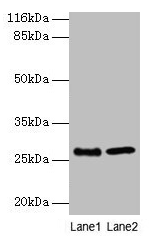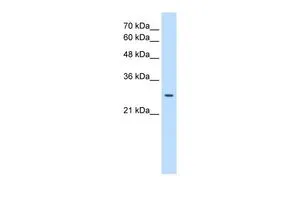
WB analysis of various sample lysates using GTX66299 EBP antibody. Dilution : 1:1000 Loading : 25microg per lane
EBP antibody
GTX66299
ApplicationsWestern Blot
Product group Antibodies
TargetEBP
Overview
- SupplierGeneTex
- Product NameEBP antibody
- Delivery Days Customer9
- Application Supplier NoteWB: 1:500 - 1:2000. *Optimal dilutions/concentrations should be determined by the researcher.Not tested in other applications.
- ApplicationsWestern Blot
- CertificationResearch Use Only
- ClonalityPolyclonal
- ConjugateUnconjugated
- Gene ID10682
- Target nameEBP
- Target descriptionEBP cholestenol delta-isomerase
- Target synonymsCDPX2, CHO2, CPX, CPXD, MEND, 3-beta-hydroxysteroid-Delta(8),Delta(7)-isomerase, 3-beta-hydroxysteroid-delta-8,delta-7-isomerase, Chondrodysplasia punctata-2, X-linked dominant (Happle syndrome), D8-D7 sterol isomerase, cholestenol Delta-isomerase, cholesterol-5,6-epoxide hydrolase subunit EBP, delta(8)-Delta(7) sterol isomerase, emopamil binding protein (sterol isomerase), emopamil-binding protein, sterol 8-isomerase
- HostRabbit
- IsotypeIgG
- Protein IDQ15125
- Protein Name3-beta-hydroxysteroid-Delta(8),Delta(7)-isomerase
- Scientific DescriptionThe protein encoded by this gene is an integral membrane protein of the endoplasmic reticulum. It is a high affinity binding protein for the antiischemic phenylalkylamine Ca2+ antagonist [3H]emopamil and the photoaffinity label [3H]azidopamil. It is similar to sigma receptors and may be a member of a superfamily of high affinity drug-binding proteins in the endoplasmic reticulum of different tissues. This protein shares structural features with bacterial and eukaryontic drug transporting proteins. It has four putative transmembrane segments and contains two conserved glutamate residues which may be involved in the transport of cationic amphiphilics. Another prominent feature of this protein is its high content of aromatic amino acid residues (>23%) in its transmembrane segments. These aromatic amino acid residues have been suggested to be involved in the drug transport by the P-glycoprotein. Mutations in this gene cause Chondrodysplasia punctata 2 (CDPX2; also known as Conradi-Hunermann syndrome). [provided by RefSeq, Jul 2008]
- Storage Instruction-20°C or -80°C,2°C to 8°C
- UNSPSC12352203




